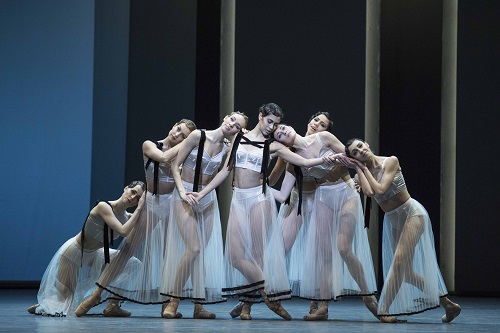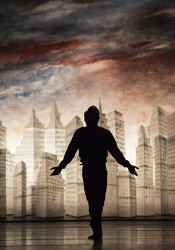 United Kingdom Bernstein Centenary – Yugen, The Age of Anxiety & Corybantic Games: Dancers of The Royal Ballet, Orchestra of the Royal Opera House / Koen Kessels & Barry Wordsworth (conductors). Directed for the screen by Ross MacGibbon and broadcast to Cineworld Basildon from The Royal Opera House, Covent Garden, London. 27.3.2018. (JPr)
United Kingdom Bernstein Centenary – Yugen, The Age of Anxiety & Corybantic Games: Dancers of The Royal Ballet, Orchestra of the Royal Opera House / Koen Kessels & Barry Wordsworth (conductors). Directed for the screen by Ross MacGibbon and broadcast to Cineworld Basildon from The Royal Opera House, Covent Garden, London. 27.3.2018. (JPr)

Yugen
Choreography – Wayne McGregor
Set designer – Edmund de Waal
Costume designer – Shirin Guild
Lighting designer – Lucy Carter
Conductor – Koen Kessels
Piano – Robert Clark
Dancers: Federico Bonelli, William Bracewell, Harry Churches, Melissa Hamilton, Francesca Hayward, Chisato Katsura, Paul Kay, Sarah Lamb, Calvin Richardson, Joseph Sissens & Akane Takada
The Age of Anxiety
Choreography – Liam Scarlett
Designer – John Macfarlane
Lighting – Jennifer Tipton
Conductor – Barry Wordsworth
Dancers included: Sarah Lamb (Rosetta), Alexander Campbell (Emble), Bennet Gartside (Quant) & Tristan Dyer (Malin)
Corybantic Games
Choreography – Christopher Wheeldon
Set designer – Jean-Marc Puissant
Costume designer – Erdem Moralioglu
Lighting designer – Peter Mumford
Conductor – Koen Kessels
Dancers: Matthew Ball, William Bracewell, Lauren Cuthbertson, Tierney Heap, Ryoichi Hirano, Mayara Magri, Yasmine Naghdi, Marcelino Sambé, Beatriz Stix-Brunell & Artists of the Royal Ballet
The Royal Ballet has a very loyal following at the Cineworld Basildon where I was able to see these three ballets with music by Leonard Bernstein to celebrate the centenary of his birth. Two by Wayne McGregor and Christopher Wheeldon were brand new and the triple bill was completed by a revival of Liam Scarlett’s 2014 Age of Anxiety. The broadcast was impeccably introduced by Ore Oduba who spoke of Bernstein as ‘a titan of 20th-century music; as a conductor he had the Midas touch and was music director of the New York Philharmonic; he was the first musician to harness the power of TV making him a worldwide celebrity; but it is his talent as a composer which we are going to celebrate tonight … The range of Bernstein’s inspiration was huge, the guy created symphonies, operas, ballets and, of course, West Side Story one of the greatest musicals of all time.’ His biographer Humphrey Burton was also there to say how ‘All three of the works we are going to see have got dance in them anyway. Age of Anxiety has a Masque, the Serenade has a kind of jazzy, boozy, dance at the end. and the words of the Chichester Psalms include [mention of] dance to the harp and the psaltery … His music is so tuneful and also so rhythmical … there is always a pulse, it is pulsating, driving forward, [has] energy. It’s a little bit old-fashioned some say, but what is old-fashioned once is now permanent.’
In general, it must be said that for me these three works didn’t do justice to their music which I was hearing for the first time. The orchestra sounded splendid through the cinema speakers and having been in the Royal Opera House only a couple of nights earlier I was surprised to realise how ‘real’ the sound we heard was in comparison to what I had experienced ‘live’. Full credit must go to the conductors Koen Kessels and Barry Wordsworth; the soloists Robert Clark (piano – The Age of Anxiety) and Sergey Levitin (violin – Corybantic Games); and the member of the Royal Opera Chorus and William Davies (solo treble) for their contribution to the opening work, Yugen.
This was choreographed by Wayne McGregor to the Chichester Psalms and he said he was seeking ‘quiet grace’ as that was his interpretation – ‘mysterious grace or profound grace’ – of the meaning of Yugen an important concept in traditional Japanese aesthetic. He wanted ‘something that has an absolute mercurial beauty.’ Ceramicist Edmund de Waal’s tall, narrow, little used – and presumably very costly – vitrines towered over the dancers upstage and apparently were there to represent the insides of ‘a cathedral … a temple … a synagogue … a sacred space’. This could equally have been as effective on a bare stage with different lighting effects from Lucy Carter. There was so much in the twisting and turning interplay between Calvin Richardson, Federico Bonelli and Sarah Lamb – as the central trio of the 11 dancers – that was reminiscent of Kenneth MacMillan’s Song of the Earth. This was reflected – and not for the last time in this programme of ballets – in Bernstein’s music as we heard some familiar motifs from the last movement of Mahler’s Das Lied von der Erde. How important the composer was to Bernstein need not be elaborated more on here. Richardson finally seems to take solace in dancing with other men and so what MacGregor gave us was the first of what would prove to be three reminders that Bernstein was bisexual – or ‘a gay man who married’ in the words of Arthur Laurents – and this was as much a theme of this celebration as was the centenary of his birth. MacGregor remarked how Yugen reveals the ‘rites of passage of this young man [Richardson]. You see him in relationship to this group … You might read it as [him] opening up at the end and finding a new way to live’, though he suggested the audience did not need to specifically look for that.
Using Bernstein’s Second Symphony – described by Humphrey Burton as more of a piano concerto – Liam Scarlett’s 2014 The Age of Anxiety is a narrative ballet based on W H Auden’s poem that inspired its composition. The choreographer explained how Auden’s epic was written after he had emigrated to New York and how ‘It was a real response to the World War and the loss of lives and the serious amount of depression the human condition went through.’ Apparently, Jerome Robbins made a ballet to it in 1949 and so did John Neumeier in 1979, though neither proved long-lived and I fear Scarlett’s effort – as commendable as it was – will not be either.
We meet three New Yorkers, Rosetta, Emble (a sailor) Quant (a businessman), and Malin (a Canadian airman) who meet in designer John Macfarlane’s authentic looking 1940’s downtown bar to drown their sorrows or find the meaning of life. After Emble picks a fight with a soldier (David Yudes) at the bar, they go back to Rosetta’s apartment to drink some more and take drugs. They dance together and look at the New York skyline, various conflicts emerge within the group not least Malin’s attraction to Emble. In the final scene, we see Malin alone in front of the Manhattan skyline and dancing a strangely upbeat solo. We quickly realise we have met these people before in movies or musicals and Scarlett catches their essence but little more. We are not quite sure what their motivations are although they all seem to be striving for something just beyond their reach. Bennet Gartside was the best of a central quartet – with Sarah Lamb (Rosetta), Alexander Campbell (Emble) and Tristan Dyer (Malin) – and brought his lonely businessman Quant to life and personified all lonely people everywhere. Nevertheless, Dyer was suitably conflicted as Malin and Campbell full of braggadocio as Emble, but neither he, nor Lamb’s Rosetta, seemed to know what they wanted from life. This might reflect Auden’s poem, but unfortunately, I have never read it. It was good to see Sarah Lamb – who usually is the epitome of sang-froid on stage – have such fun with the sexiness of the ‘tart with a heart’ or ‘girl on the make’.

When his Second Symphony had its premiere in 1949, Bernstein was at the piano and in 1954 he conducted the first performance of Serenade (after Plato’s Symposium) which Christopher Wheeldon chose for his new Corybantic Games. This Serenade is essentially a violin concerto with five movements and the music is redolent of the emotional essence of Plato’s text about different types of love. We were told the title refers to ‘the dancers who worshipped in the temples of old’. Wheeldon described how Bernstein’s music which goes from the ‘quiet and contemplative’ to the ‘bombastic’ must be very exciting to dance to and ‘I suppose even more exciting to create to because you can pull apart the various layers of the music and make them visual through movement.’ He wanted the ‘spirit of the first Olympics, that kind of male-dominated physicality laced with homo-erotic tenderness’. Although the César Franck music used is rather different, I thought I saw hints of Ashton’s Symphonic Variations in Wheeldon’s first new abstract ballet for some while.
The outfits for the dancers (by Erdem Moralioglu) were not very flattering and consisted of almost flesh-coloured unitards for men; with the women mainly throughout in their underwear though they also had some black trimmed pleated gauze; whilst for both some black straps flapped distractingly. The Rothko-inspired back drop by Jean-Marc Puissant also overwhelmed the dancing and a bare stage – with suitably atmospheric lighting – might have been better once again. Perhaps as Wheeldon’s homage to Plato, members of the 26-strong ensemble came together from time to time like figures on a Greek frieze. Elsewhere there were many of the over-used gymnastic tropes of modern dance already seen in Yugen, but strangely the whole evening took off for me with Beatriz Stix-Brunell’s lyrical solo in Part II, followed by the roistering of Mayara Magri and Marcelino Sambé in Part III, and the exploration of sexuality of the three couples – two women (Beatriz Stix-Brunell/Yasmine Naghdi), two men (Matthew Ball/William Bracewell) and one man-woman (Lauren Cuthbertson/Ryoicho Hirano) – before Tierney Heap’s Amazonian feistiness summoned up a frenzied conclusion.
Jim Pritchard
For more about what is on at the Royal Opera House and at a cinema near you please click here.